牛津译林版(2019)必修 第二册Unit 2 Be sporty,be healthy Extended reading课件-(共17张PPT)
文档属性
| 名称 | 牛津译林版(2019)必修 第二册Unit 2 Be sporty,be healthy Extended reading课件-(共17张PPT) | 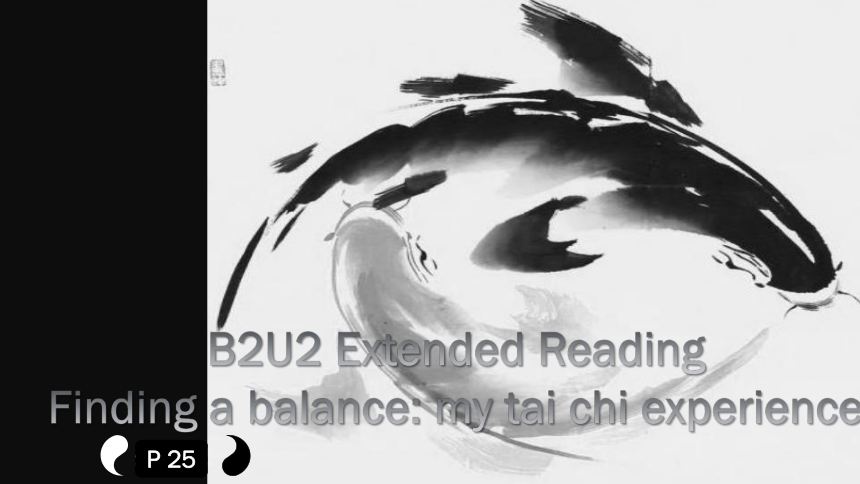 | |
| 格式 | pptx | ||
| 文件大小 | 49.1MB | ||
| 资源类型 | 教案 | ||
| 版本资源 | 牛津译林版(2019) | ||
| 科目 | 英语 | ||
| 更新时间 | 2024-03-20 11:02:37 | ||
图片预览

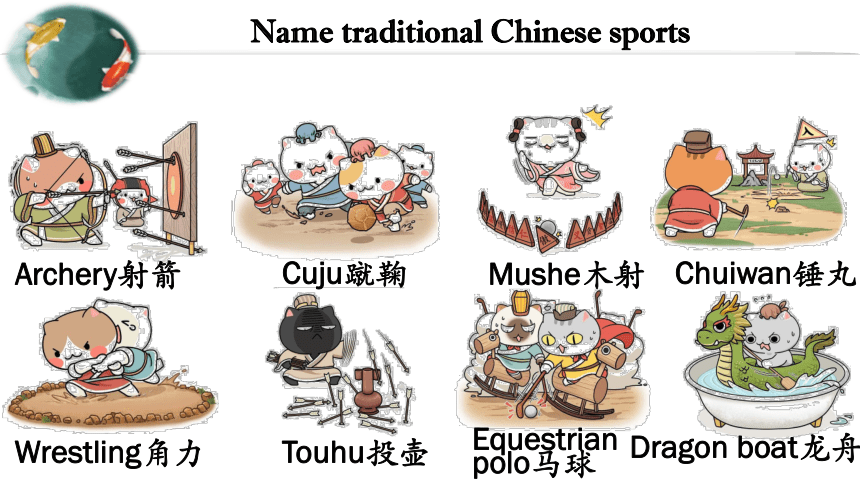
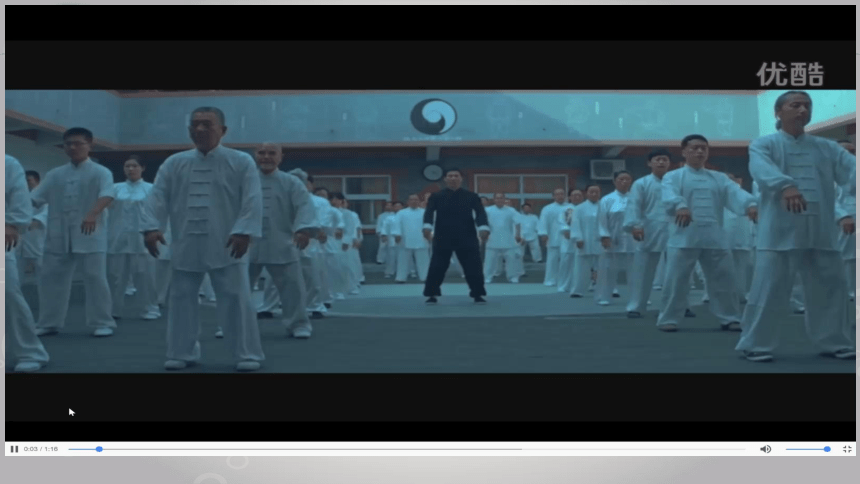
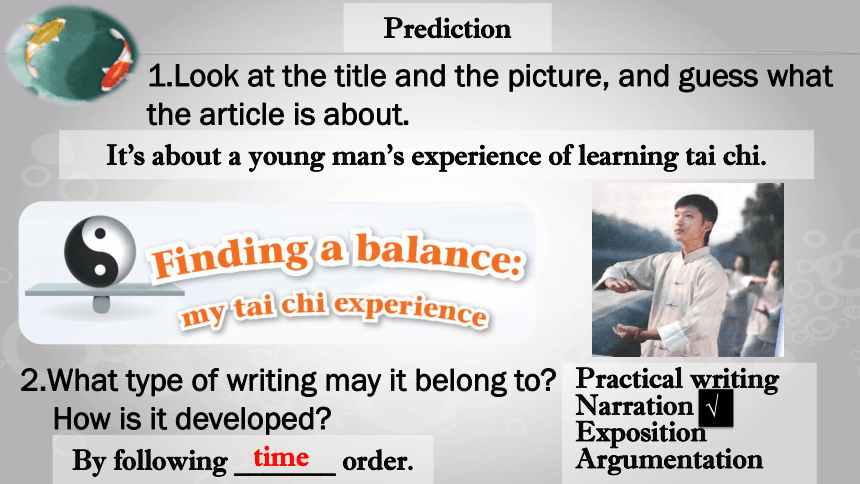
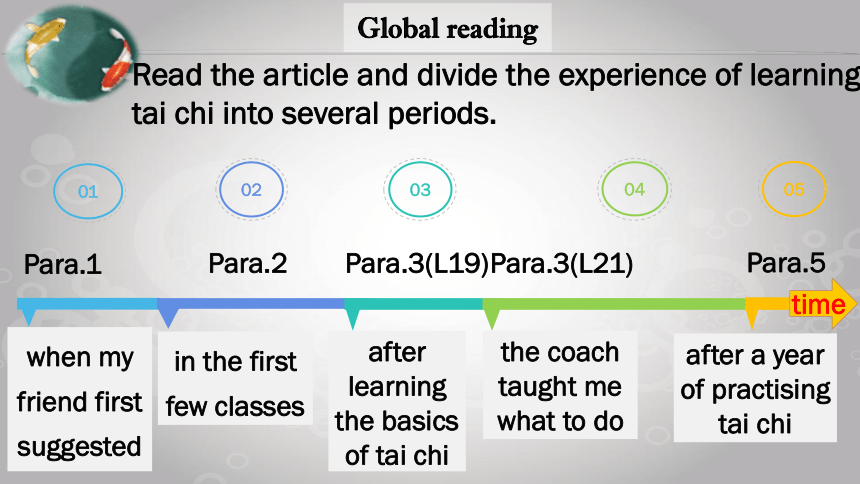

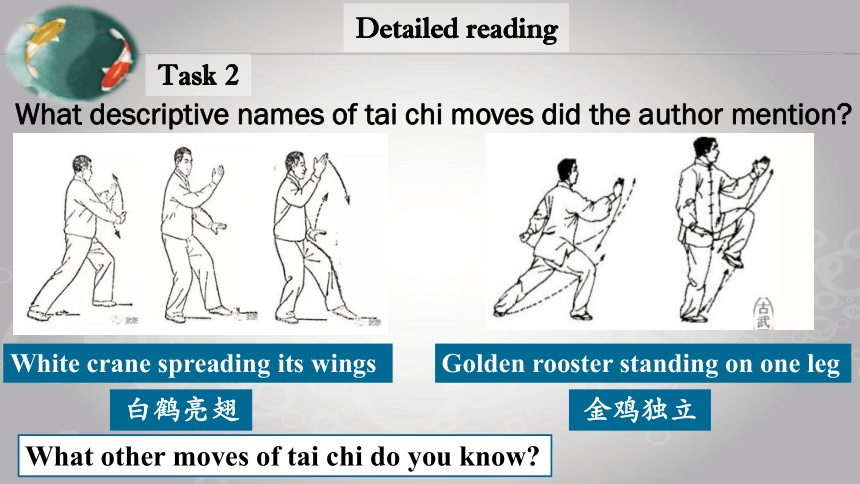
文档简介
(共17张PPT)
B2U2 Extended Reading
Finding a balance: my tai chi experience
P 25
Name traditional Chinese sports
Cuju蹴鞠
Equestrian polo马球
Chuiwan锤丸
Mushe木射
Archery射箭
Wrestling角力
Touhu投壶
Dragon boat龙舟
1.Look at the title and the picture, and guess what the article is about.
Prediction
It’s about a young man’s experience of learning tai chi.
2.What type of writing may it belong to
How is it developed
Practical writing
Narration
Exposition
Argumentation
√
By following _______ order.
time
Global reading
Read the article and divide the experience of learning tai chi into several periods.
when my friend first suggested
01
02
03
04
05
time
in the first
few classes
after learning the basics
of tai chi
the coach taught me what to do
after a year of practising
tai chi
Para.1
Para.2
Para.3(L19)
Para.3(L21)
Para.5
Detailed reading
Read the article again and describe the author’s feelings
in different periods using adjectives and explain the reasons.
Task 1
time
when my friend first suggested
in the first
few classes
after learning
the basics
the coach taught me what to do
after a year of practising tai chi
feelings
hesitant
for old people
amazed
moves with descriptive names caught my imagination
bored&aching
doing the same moves over and over again
satisfied
balance and flexibility slowly improved & be able to do more difficult moves
happier &more confident
a positive
effect &
benefits
Detailed reading
Task 2
What descriptive names of tai chi moves did the author mention
White crane spreading its wings
白鹤亮翅
Golden rooster standing on one leg
金鸡独立
What other moves of tai chi do you know
右蹬脚
倒卷宏
手挥琵琶
海底针
单鞭
左揽雀尾
Where do these interesting names moves come from
The history of tai chi.
Para.2
History
Who
Zhang Sanfeng,
a 13th-century Taoist
Chen Wangting,
a 17th-century master of Chinese martial arts
Draw inspiration from a fight between a snake and a bird
Develop tai chi based on martial arts skills. Chinese martial arts have a long-standing practice of imitating animals.
How
Similarity
Both had a connection with animals
Development
Chen-style, Yang-style,
Wu-style, Sun-style
Detailed reading
Task 3
Q1: Apart from history, what did the author learn about tai chi
The culture behind tai chi
/The essence(精髓) of tai chi
Para.4
is rooted in Chinese philosophy of ______________
yin and yang
the unity of _____________
opposites
The practice of tai chi aims to _____________________ in the body through
______________________
opposite movements
maintain the balance
left and right
breathing in and breathing out
forwards and backwards
up and down
Tai chi brings about a state of __________________ and ______________
physical balance
mental peace
Q1: How do you understand “there is no shadow without light” in Line32 Why is it used here
Creative thinking
Where there is light, there is a shadow.
The author uses this example to explain the unity of opposites --Neither can exist independent without the other.
Q2: Can you make up more examples to explain the unity of opposites
There is no good without evil.
There is no fairness without unfairness.
There is no white without black.
There is no beauty without ugliness.
There is no success without failure.
…
There is no _________ without ________.
life
death
Q3: What can we learn from the unity of opposites and
Chinese philosophy of yin and yang
Creative thinking
The world is made up of opposite forces and neither of them can be independent of the other. The opposites always keep balance and no one could break it. If the balance is broken, an imbalance may occur, which could cause many problems.
As senior high school students, we should know how to keep a balance between study and play. As the sayings goes, “The moon waxes only to wane, water brims only to overflow.(月满则亏,水满则溢)”. On the one hand, all work and no play makes Jack a dull boy. On the other hand, all play and no work gives Jack a poor score.
Actually, what we should do is to study mainly and relax properly.
Discussion
Do you think tai chi will get more popular among teenagers Why or why not
I think tai chi will get more popular among teenagers because:
tai chi has a positive effect on teenagers physically and mentally(Line4);
tai chi inspires teenagers to explore the Chinese culture behind it(Line5).
tai chi brings about a state of physical balance and mental peace(Line15);
tai chi makes teenagers sleep better at night and more energetic during the day(Line38);
tai chi teaches teenagers to relax mind, enabling them to stay cool in stressful situations(Line39);
I think tai chi will not get more popular among teenagers because:
tai chi isn’t to teenagers’ taste because of its slow pace;
tai chi takes much time;
tai chi is not practical for teenagers with heavy study pressure.
President Xi's view on sports
1. If the young are strong, China will be strong.
If sports are strong, China will be strong.
2. Civilized in Spirit, Unrestrained the flesh.
3. Our national fitness program is our national happiness program.
4. We will combine our Chinese dream with the dream of sports power.
少年强则中国强。体育强则中国强。
文明其精神,野蛮其体魄。
要把体育强国梦和中国梦扣在一起。
全民健身计划就是国民幸福计划。
Doing exercise is not only beneficial to our personal health and future life,
but can also make China stronger and healthier.
Keep
moving !
Whatever sport you take up,
the point is to
B2U2 Extended Reading
Finding a balance: my tai chi experience
P 25
Name traditional Chinese sports
Cuju蹴鞠
Equestrian polo马球
Chuiwan锤丸
Mushe木射
Archery射箭
Wrestling角力
Touhu投壶
Dragon boat龙舟
1.Look at the title and the picture, and guess what the article is about.
Prediction
It’s about a young man’s experience of learning tai chi.
2.What type of writing may it belong to
How is it developed
Practical writing
Narration
Exposition
Argumentation
√
By following _______ order.
time
Global reading
Read the article and divide the experience of learning tai chi into several periods.
when my friend first suggested
01
02
03
04
05
time
in the first
few classes
after learning the basics
of tai chi
the coach taught me what to do
after a year of practising
tai chi
Para.1
Para.2
Para.3(L19)
Para.3(L21)
Para.5
Detailed reading
Read the article again and describe the author’s feelings
in different periods using adjectives and explain the reasons.
Task 1
time
when my friend first suggested
in the first
few classes
after learning
the basics
the coach taught me what to do
after a year of practising tai chi
feelings
hesitant
for old people
amazed
moves with descriptive names caught my imagination
bored&aching
doing the same moves over and over again
satisfied
balance and flexibility slowly improved & be able to do more difficult moves
happier &more confident
a positive
effect &
benefits
Detailed reading
Task 2
What descriptive names of tai chi moves did the author mention
White crane spreading its wings
白鹤亮翅
Golden rooster standing on one leg
金鸡独立
What other moves of tai chi do you know
右蹬脚
倒卷宏
手挥琵琶
海底针
单鞭
左揽雀尾
Where do these interesting names moves come from
The history of tai chi.
Para.2
History
Who
Zhang Sanfeng,
a 13th-century Taoist
Chen Wangting,
a 17th-century master of Chinese martial arts
Draw inspiration from a fight between a snake and a bird
Develop tai chi based on martial arts skills. Chinese martial arts have a long-standing practice of imitating animals.
How
Similarity
Both had a connection with animals
Development
Chen-style, Yang-style,
Wu-style, Sun-style
Detailed reading
Task 3
Q1: Apart from history, what did the author learn about tai chi
The culture behind tai chi
/The essence(精髓) of tai chi
Para.4
is rooted in Chinese philosophy of ______________
yin and yang
the unity of _____________
opposites
The practice of tai chi aims to _____________________ in the body through
______________________
opposite movements
maintain the balance
left and right
breathing in and breathing out
forwards and backwards
up and down
Tai chi brings about a state of __________________ and ______________
physical balance
mental peace
Q1: How do you understand “there is no shadow without light” in Line32 Why is it used here
Creative thinking
Where there is light, there is a shadow.
The author uses this example to explain the unity of opposites --Neither can exist independent without the other.
Q2: Can you make up more examples to explain the unity of opposites
There is no good without evil.
There is no fairness without unfairness.
There is no white without black.
There is no beauty without ugliness.
There is no success without failure.
…
There is no _________ without ________.
life
death
Q3: What can we learn from the unity of opposites and
Chinese philosophy of yin and yang
Creative thinking
The world is made up of opposite forces and neither of them can be independent of the other. The opposites always keep balance and no one could break it. If the balance is broken, an imbalance may occur, which could cause many problems.
As senior high school students, we should know how to keep a balance between study and play. As the sayings goes, “The moon waxes only to wane, water brims only to overflow.(月满则亏,水满则溢)”. On the one hand, all work and no play makes Jack a dull boy. On the other hand, all play and no work gives Jack a poor score.
Actually, what we should do is to study mainly and relax properly.
Discussion
Do you think tai chi will get more popular among teenagers Why or why not
I think tai chi will get more popular among teenagers because:
tai chi has a positive effect on teenagers physically and mentally(Line4);
tai chi inspires teenagers to explore the Chinese culture behind it(Line5).
tai chi brings about a state of physical balance and mental peace(Line15);
tai chi makes teenagers sleep better at night and more energetic during the day(Line38);
tai chi teaches teenagers to relax mind, enabling them to stay cool in stressful situations(Line39);
I think tai chi will not get more popular among teenagers because:
tai chi isn’t to teenagers’ taste because of its slow pace;
tai chi takes much time;
tai chi is not practical for teenagers with heavy study pressure.
President Xi's view on sports
1. If the young are strong, China will be strong.
If sports are strong, China will be strong.
2. Civilized in Spirit, Unrestrained the flesh.
3. Our national fitness program is our national happiness program.
4. We will combine our Chinese dream with the dream of sports power.
少年强则中国强。体育强则中国强。
文明其精神,野蛮其体魄。
要把体育强国梦和中国梦扣在一起。
全民健身计划就是国民幸福计划。
Doing exercise is not only beneficial to our personal health and future life,
but can also make China stronger and healthier.
Keep
moving !
Whatever sport you take up,
the point is to
